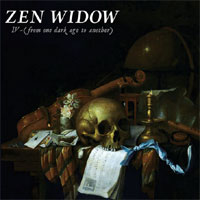Zen Widow • IV-(from one dark age to another) Objet-a LP-2023001
The music on this record, a look back to songs hundreds of decades old, is hard to describe and even harder to wrap your head around. The free improvisation of the trio, projected through differing interpretive lenses, ranges from medieval chant to folk melody to Bach, though for some it may be difficult to identify the source. It was for me. Nonetheless, I was often lost in the energetic flow of the music as it cascaded to and fro in a tactile acoustic space, filled with sonic delights of the highest order. Given the exceptional details of the album’s creation, I was expecting an above-average listening experience. I was not disappointed, but I was also rather puzzled. Side one opens with “Gesualdo,” a homage to the 17th-century Italian nobleman and composer, Carlo Gesualdo da Venosa. His madrigal, “Moro, Lasso, al Mio Duolo,” from 1611, was unusual, for the time, in its use of dissonance. Perhaps that’s why it was chosen as a point of departure for the members of Zen Widow. It is a melancholy, barely moving showcase for the soprano sax of Gianni Gebbia. It ebbs and flows in a soundscape of amazing clarity and dynamics. The delicate taps on the cymbals are startling in their immediacy. Later on, the drums explode into the soundstage and the track gains energy and, taken with the piano in the background, leads the ensemble into a cohesive whole. This unsettling track is followed by “Can y Washel,” a tune derived from early Welsh folk melodies. Again the sax takes center stage with a catchy melody and is soon joined by the drums with the piano noodling in the background (seemingly in another world). The cut soon descends into chaos. “Bachernaught,” an apparent nod to Bach, is the next tune. The notes say it is based on his cello suites, but I found that difficult to identify. The repeating, Philip Glass-style sax lines, playing against the cymbals and lightly struck gong are a sonic delight, but, later on, the sustained tones from both piano and sax lost me. Gianni’s skills at circular breathing are well demonstrated on this track. Finally, the side closes with “The Subtle Arts,” sourced from the Chantilly Codex, early music characterized by rhythmic and notational complexity. This it most certainly is, as the amazing opening drum intro leads to the sax and piano partaking in a free-flowing, organic and uniquely lovely bit of music-making. Side 2 opens with “Sic Mea Fata,” based partly on the often rowdy and randy anonymous compositions found in the 13th-century Codex Burana, considered one of the most important assemblages of songs of all time. Solo piano opens the track with a gospel-flavored melody soon joined by the sax, which takes over with a spirited continuation of the theme. After a riotous jam, the track ends quietly. Next up is “Flete, Fidelis, Anime,” from the same Codex Burana. This track will give your woofers and/or subwoofers a real workout. Opening with a whistle, gong (which I’ve named Gongzilla) and deep, deep bass drum, it evolves into the most abstract, ambient-like music on this record. With the sax’s woeful sound, punctuated by sudden outbursts from the percussion, I found it unnerving. By showcasing the variety of percussive effects at hand, it is definitely Garth Powell’s show. Inspired by the hammered dulcimer and early wind instruments, “Evagrius” finds Gianni adapting his soprano sax into a cornettophone, the result of which sounds, to me, like the Armenian duduk. The drums establish a Far Eastern rhythm and mood with the plucked piano propelling the music forward. Finally, for the album’s closer, vocalist Dwight Trible contributes his talents to “Gower Wassail,” a traditional Welsh folk song celebrating the properties of the beverage wassail (cider). It is the most traditional-sounding tune on the album, with Trible’s voice becoming another instrument in the ensemble, turning the trio into a quartet. High-res digital processing was used here to accommodate Trible’s voice, the only use of digital technology on the album. Now, the important stuff for audiophiles: production by Joe Harley, a recording made live to two-track analog tape, and 100% analog mastering by Kevin Gray at Cohearent Audio. The LP was pressed at RTI and housed in a lovely Stoughton gatefold jacket. Shane Buettner at Intervention Records is distributing the LP through a collaborative effort with Italian label Object-a, and the sound is as outstanding -- airy, delicate and supremely well resolved -- as the music is challenging. I really need to spend more time with this album to
overcome my initial uncertain reaction. Nonetheless, it’s sonically stunning and
musically challenging. If those properties appeal to you, seek out this album. Maybe you
can explain it to me. |

 ho or what is Zen Widow? Some
Internet research revealed that it is an improvisational jazz trio comprised of
Sicily’s Gianni Gebbia, soprano sax and cornettophone, and founder of the Objet-a
music label; New Yorker Matthew Goodheart, grand piano and computer-actuated gongs; and
Los Angeles native Garth Powell, drums, percussion and gongs. If Powell's name sounds
familiar, that's because he is AudioQuest’s Senior Director of Engineering. For this,
the group’s fourth release, they are joined by vocalist Dwight Trible on one cut.
ho or what is Zen Widow? Some
Internet research revealed that it is an improvisational jazz trio comprised of
Sicily’s Gianni Gebbia, soprano sax and cornettophone, and founder of the Objet-a
music label; New Yorker Matthew Goodheart, grand piano and computer-actuated gongs; and
Los Angeles native Garth Powell, drums, percussion and gongs. If Powell's name sounds
familiar, that's because he is AudioQuest’s Senior Director of Engineering. For this,
the group’s fourth release, they are joined by vocalist Dwight Trible on one cut.